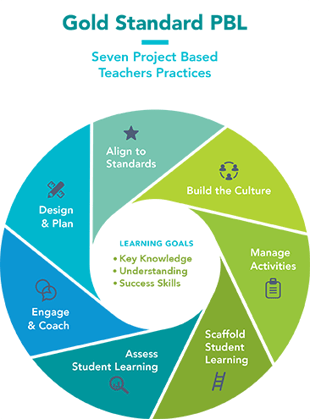Sometimes, when teachers and school leaders hear about project-based learning (PBL), it sounds like a whole new thing. They can’t imagine adding any more to their already-full plates. They may think it’s so different from what they are already doing that everything has to change, from lesson planning to instructional practices to student assessment systems to teacher evaluation.
It’s true that PBL in its purer, fully-developed form does represent a shift in thinking about what and how students should learn. Teaching a project is different than predominantly using lectures, worksheets, and textbooks all day, every day. But it’s possible—I’d even say advisable—to ease into the shift, and begin using PBL without changing everything at once. Once teachers try doing one or two projects and get the hang of it, they will feel more comfortable with PBL and see how it fits with many things they are already doing.
One of those things teachers and schools are already doing is using effective teaching frameworks to guide their practice, professional development, and evaluation systems. Two of the most common frameworks are the Danielson Framework for Teaching and the Marzano Teacher Evaluation Model. States, schools and districts, universities and other education organizations have adopted these frameworks or created their own by adapting them.
When I read these frameworks, I can immediately see how they align with project-based learning. I’ll explain the connection specifically in a series of blog posts; this first post is an introduction.
Project Based Teaching
Just so we’re on the same page, I’d like to start by explaining where I’m coming from. In the book Project Based Teaching, which I edited and co-authored, we expanded on the Buck Institute for Education’s model for “Gold Standard PBL” that I co-developed. We made the point that project-based teaching includes many of the same features of what people think of as “traditional” teaching. You can see this in the following descriptions of the seven Project Based Teaching Practices:
1. Design & Plan
Teachers create or adapt a project for their context and students, and plan its implementation from launch to culmination while allowing for some degree of student voice and choice.
2. Align to Standards
Teachers use standards to plan the project and make sure it addresses key knowledge and understanding from subject areas to be included.
3. Build the Culture
Teachers explicitly and implicitly promote student independence and growth, open-ended inquiry, team spirit, and attention to quality.
4. Manage Activities
Teachers work with students to organize tasks and schedules, set checkpoints and deadlines, find and use resources, create products and make them public.
5. Scaffold Student Learning
Teachers employ a variety of lessons, tools, and instructional strategies to support all students in reaching project goals.
6. Assess Student Learning
Teachers use formative and summative assessments of knowledge, understanding, and success skills, and include self and peer assessment of team and individual work.
7. Engage & Coach
Teachers engage in learning and creating alongside students, and identify when they need skill-building, redirection, encouragement, and celebration.

The Effectiveness Frameworks
The Danielson Framework for Teaching has four domains:
- Planning and Preparation
- The Classroom Environment
- Instruction
- Professional Responsibilities
The Marzano Focused Teacher Evaluation Model has four domains:
- Standards-Based Planning
- Standards-Based Instruction
- Conditions for Learning
- Professional Responsibilities
As you can see, the two frameworks are pretty close, and they’re easy to match to PBL. The first two of the Buck Institute’s Project Based Teaching Practices are about planning, so they align with the first of Danielson’s and Marzano’s domains. Practice 3, Build the Culture, aligns with classroom environment and conditions. Practices 4, 5, 6 and 7 align with instruction.
In my next post, I’ll talk specifically about planning. My third post will be about instruction, and the fourth about classroom environment. The frameworks’ fourth domain, professional responsibilities, would be the same whether a teacher is using PBL or not—so I won’t be covering that.
We’ll get into the specifics soon. For now, rest assured that making the shift to PBL can a be smoother process than you might think!
About the author:
John Larmer is a project-based learning expert. In his 20 years at the Buck Institute for Education/PBLWorks, he co-developed the model for Gold Standard PBL, authored several books and many blog posts, and contributed to curriculum and professional development. He is now an independent consultant who has written a forthcoming book on civic education for K-8 teachers, is writing a PBL history curriculum for Educurious, and develops civics performance tasks for Defined Learning.